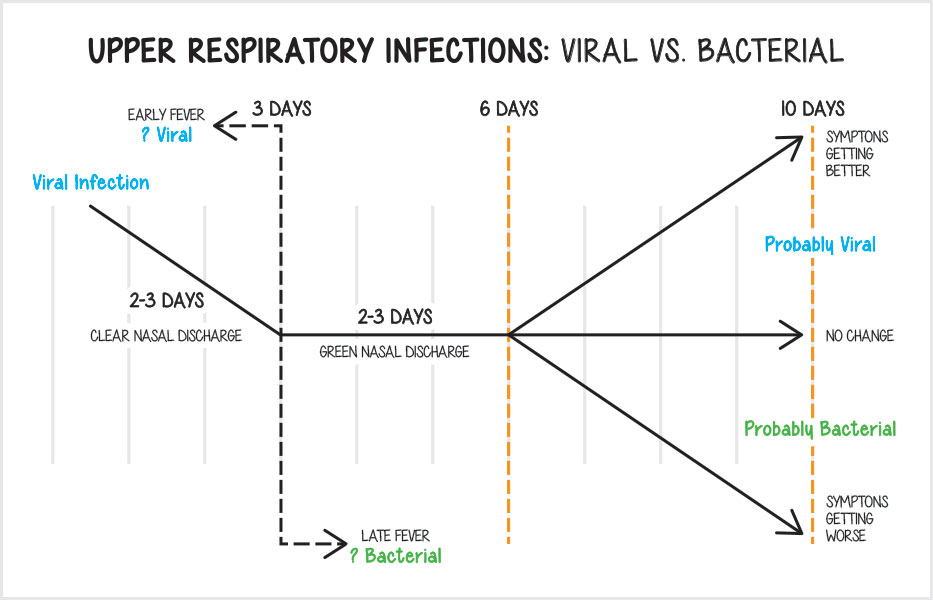Colds are part of life; we all get them, regardless of our age or state of health. Yet for parents, particularly parents of young children in daycare, they can seem almost like a perpetual problem. Why is that? Glad you asked!
There are likely close to 200 different respiratory viruses that can cause the common cold — AND the immunity a human develops to respiratory viruses lasts only about 5 years, which explains why even people like me, exposed to these viruses for decades, still get colds.
Now the hard part: the average respiratory viral infection (cold) can take a child up to 21 days to completely clear, while an adult may take 14 to 21 days. The number of colds per year can also vary widely, depending for example, on whether your child stays at home with you until she’s 3, is in a day care with just a few children, or in a large daycare with 13 other babies in her area.
In the 1960s, a very diligent researcher at the University of North Carolina, Floyd W. Denny, MD, studied the number of Upper Respiratory Infections (URIs) children got. He found that the number of colds for children in daycare rose with the number of children: 1-4 children had the fewest, 5-8 intermediate, and 9 or more, having the most. In fact, the latter group averaged 9-14 respiratory illness per year. Now do the math. If Suzy had 14 respiratory infections, each lasting 21 days, she would be sick 294 days! So assuming no colds in the summer, you could pretty much have colds the entire school year.
The other striking thing that Dr. Denny discovered is that by age 5 years, virtually all children had experienced about the same number of URIs. Thus, children in early daycare pay their dues early, and by 3 years, seldom catch a cold. Children who stay home, then go to preschool at 3 years of age suddenly are sick all the time!
So what does a typical cold look like? Adults know about the mild headache and sore throat that often herald a cold, so in a nonverbal baby that would mean fussy! Then Bobby might have a low-grade fever, some congestion, and a clear nasal discharge, which over the next 3 days, starts to become thicker, greener, and of much bigger volume. By the 4th or 5th day, the cold has reached it’s worst, what I like to call the pit. Typically any cough, as well the nasal discharge, are peaking. There should NOT be any fever at this point, that is, by day 5. If there is, Bobby needs to be seen.
By the 6th or 7th day, the discharge volume, consistency, and color begin to improve, though you may not fully appreciate this until day 10 to 12. Thereafter, it will still usually take another 8-10 days for all the drainage and cough to disappear. The diagram below visually describes this process.
So what happened? To answer that, a quick lesson on inflammatory response. The inflammatory response is what your child’s body initiates after it is exposed to one of the respiratory viruses, which was the trigger: Fever, irritability (because Annie’s throat hurts, but she can’t tell you), hoarse voice, nasal discharge are all part of that inflammatory response. Here’s the key: once the virus triggers that response, there is NOTHING that can be done to end the cycle.
In fact, I like to refer to it as NATURE’S VIRAL DISHWASHER CYCLE: Rinse, Scrub, Rinse. First the nasal discharge is clear (2-3 days), and then it becomes colored, often frankly green (2-4 days), before it slowly starts to improve (3-4 days more before it’s really clear the color is improving).
Many parents come in because of the green nasal discharge on day 5, and ask for antibiotics to treat their child’s “sinus infection.” Though a very ill appearing child with a high fever might have a bacterial sinus infection, in the vast majority of cases the child is in the “scrub cycle” of the virus.
Implicit in what I’ve said thus far is that all of the “cold remedies” are in fact not remedies. Symptoms such as sore throat pain can be treated with ibuprofen (Motrin) or acetaminophen (Tylenol). Children 8 years or older may get some relief of the nasal symptoms using Neil Med Sinus Rinse — available over the counter.
So when should you call us, and consider an office visit? Certainly a child who appears quite ill and apathetic should always be seen the same day. Likewise a provider should see a child with fever lasting more than 5 days, localizing pain such as earache, or absolutely no sign of improvement by the 10th day.
A final word about prevention: Respiratory viruses infect by droplet spread. The infectious droplets are heavy; they don’t float across the room like aerosolized viruses such as measles or chickenpox. An infected person is spewing these droplets by the thousands as they talk. Some land on Chuckie’s pencil. Chuckie touches the pencil, then typically touches his nose or eyes, thus infecting him. Simple hand washing will interrupt that process.
Newborns and young infants rarely bring their hands to their faces, so they are at risk if an infected older sibling or adult stands right over the babies face. As the infected individual speaks, the droplets pour out, land in baby’s eyes, infecting her!
People always worry about strangers infecting their child. You should be much more afraid of Auntie or Grandma with a cold, as she will insist on holding the baby right under the faucet of viruses pouring out of her nose, infecting little Angelina. A diplomatically offered mask and good hand washing would protect baby and preserve family relations.
